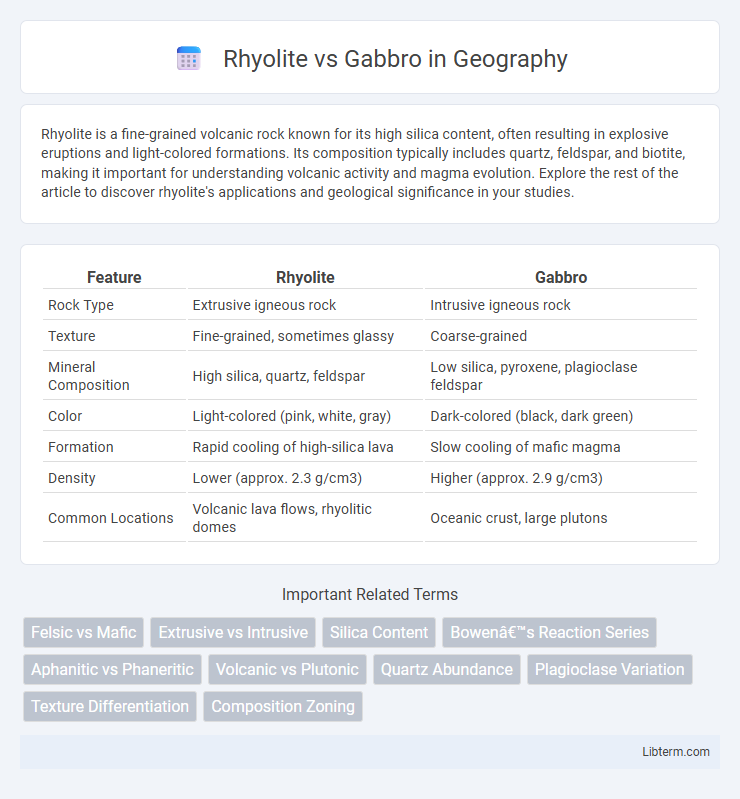Rhyolite is a fine-grained volcanic rock known for its high silica content, often resulting in explosive eruptions and light-colored formations. Its composition typically includes quartz, feldspar, and biotite, making it important for understanding volcanic activity and magma evolution. Explore the rest of the article to discover rhyolite's applications and geological significance in your studies.
Table of Comparison
| Feature | Rhyolite | Gabbro |
|---|---|---|
| Rock Type | Extrusive igneous rock | Intrusive igneous rock |
| Texture | Fine-grained, sometimes glassy | Coarse-grained |
| Mineral Composition | High silica, quartz, feldspar | Low silica, pyroxene, plagioclase feldspar |
| Color | Light-colored (pink, white, gray) | Dark-colored (black, dark green) |
| Formation | Rapid cooling of high-silica lava | Slow cooling of mafic magma |
| Density | Lower (approx. 2.3 g/cm3) | Higher (approx. 2.9 g/cm3) |
| Common Locations | Volcanic lava flows, rhyolitic domes | Oceanic crust, large plutons |
Introduction to Rhyolite and Gabbro
Rhyolite and gabbro are igneous rocks with distinct compositions and textures, where rhyolite is a fine-grained, felsic rock rich in silica, while gabbro is a coarse-grained, mafic rock abundant in iron and magnesium minerals. Rhyolite typically forms from high-viscosity lava during explosive volcanic eruptions, leading to rapid cooling and fine-grained textures. Gabbro crystallizes slowly beneath the Earth's surface in large plutonic bodies, resulting in its coarse-grained structure and dark mineral content.
Formation Processes of Rhyolite and Gabbro
Rhyolite forms from the rapid cooling of high-silica, felsic lava at the Earth's surface, resulting in fine-grained, often glassy textures. Gabbro crystallizes slowly beneath the Earth's surface from mafic magma, allowing the growth of coarse-grained, interlocking mineral crystals. The contrasting cooling rates and compositional differences between rhyolite and gabbro directly influence their distinct textures and mineralogy.
Mineral Composition Comparison
Rhyolite primarily consists of high silica content with dominant minerals like quartz, potassium feldspar, and plagioclase, whereas gabbro contains lower silica levels and is rich in mafic minerals such as pyroxene and calcium-rich plagioclase. Rhyolite's mineral composition reflects its felsic nature, emphasizing light-colored minerals, while gabbro's mafic composition includes dark-colored, iron and magnesium-bearing minerals. The contrasting mineral assemblages in rhyolite and gabbro highlight their formation from different magma chemistries, affecting texture and color.
Color and Texture Differences
Rhyolite displays a light color palette ranging from pink to light gray, characterized by a fine-grained, often glassy texture due to rapid cooling of high-silica magma. Gabbro, in contrast, exhibits dark colors such as black or dark green with a coarse-grained, phaneritic texture formed from slow cooling of low-silica, mafic magma deep within the Earth. These color and texture differences directly reflect their distinct mineral compositions and crystallization environments.
Physical Properties and Density
Rhyolite presents a fine-grained texture with a primarily light-colored, high silica content, resulting in lower density typically around 2.3 to 2.5 g/cm3. Gabbro, characterized by its coarse-grained texture and dark, mafic minerals, exhibits higher density values usually ranging from 2.7 to 3.3 g/cm3. The difference in mineral composition influences their physical properties, with rhyolite being lighter and less dense compared to the denser, heavier gabbro.
Geological Occurrences and Locations
Rhyolite commonly occurs in continental volcanic arcs and caldera settings, often associated with high-silica volcanic eruptions in regions like the Yellowstone Plateau and the Taupo Volcanic Zone in New Zealand. Gabbro forms primarily in oceanic crust and layered mafic intrusions, such as the Oman Ophiolite and the Bushveld Igneous Complex in South Africa. The contrasting geological environments reflect rhyolite's extrusive volcanic origin and gabbro's intrusive plutonic nature.
Uses in Industry and Construction
Rhyolite's fine-grained texture and high silica content make it ideal for decorative aggregates, dimension stone, and ornamental applications in architecture, while its relative hardness limits its use in heavy construction. Gabbro's coarse-grained structure and high durability contribute to its widespread use as crushed stone for road base, railroad ballast, and concrete aggregate, offering excellent strength and resistance to abrasion. Industrially, gabbro's mineral composition allows extraction of valuable metals like nickel and chromium, whereas rhyolite's industrial applications are limited mostly to ceramics and glass manufacturing.
Weathering and Durability
Rhyolite weathers more rapidly than gabbro due to its high silica content and fine-grained texture, making it less durable in exposed environments. Gabbro's coarse-grained structure and mafic mineral composition contribute to greater resistance against physical and chemical weathering. This durability difference makes gabbro more suitable for construction projects requiring long-term stability.
Identification Tips for Rhyolite vs Gabbro
Rhyolite can be identified by its fine-grained texture and light color, typically pink or light gray, with visible quartz and feldspar crystals, while gabbro is coarse-grained, dark-colored, and composed mainly of pyroxene and plagioclase feldspar. Rhyolite forms from rapid cooling of high-silica magma at the earth's surface, whereas gabbro crystallizes slowly underground from low-silica magma, resulting in larger mineral grains. Key identification tips include examining grain size, mineral composition, and color contrast to distinguish rhyolite's volcanic origin from gabbro's plutonic nature.
Summary: Key Differences and Similarities
Rhyolite and gabbro are igneous rocks with contrasting compositions; rhyolite is felsic and rich in silica, while gabbro is mafic and contains higher amounts of iron and magnesium. Both rocks crystallize from magma, but rhyolite forms extrusively with fine-grained textures, whereas gabbro cools slowly underground, resulting in coarse-grained crystals. Despite these differences, both contribute to understanding igneous processes and the Earth's crust composition.
Rhyolite Infographic

 libterm.com
libterm.com